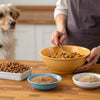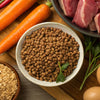Is Dog Kibble Bad? Understanding the Pros and Cons of Dry Dog Food
- Houndsy
Table of Contents
- Introduction
- The Basics of Dog Kibble
- The Pros of Feeding Kibble
- The Cons of Feeding Kibble
- Alternatives to Kibble
- Enhancing Your Dog's Feeding Experience
- Conclusion
Introduction
As dog lovers, we often find ourselves wondering about the best ways to nourish our furry companions. With statistics revealing that nearly 60% of dogs are overweight or obese, the importance of a balanced diet cannot be overstated. But with so many options available, many pet owners are left asking, “Is dog kibble bad?”
In recent years, the debate surrounding kibble has intensified, with arguments both for and against its suitability as a staple in our dogs' diets. The convenience of kibble, often touted as a quick and easy solution for busy pet parents, can sometimes mask underlying concerns about nutrition and ingredient quality. This blog post aims to explore the various aspects of dog kibble, including its benefits and drawbacks, while also offering alternatives that align with our mission at Houndsy: to simplify and elevate the dog-feeding experience.
By the end of this article, we hope to provide you with a comprehensive understanding of whether kibble is truly bad for dogs, and what you can do to ensure your pet enjoys a nutritious and wholesome diet. We’ll delve into the ingredients commonly found in kibble, the potential health implications of feeding your dog dry food, and practical tips for enhancing your pet's mealtime experience.
Let’s embark on this journey together and discover what’s best for our four-legged friends!
The Basics of Dog Kibble
What is Kibble?
Kibble is a form of dry dog food made through a process called extrusion. In this process, various ingredients like meat, grains, and vegetables are cooked at high temperatures, then shaped into small, bite-sized pieces. This method allows kibble to have a long shelf life and makes it convenient for pet owners to store and serve. However, the high temperatures involved in the processing can also lead to the loss of vital nutrients, raising questions about the overall quality of the food.
Understanding Ingredients
The ingredient list of kibble can be a mix of high-quality proteins and fillers. Here are some common components:
- Protein Sources: Ideally, high-quality kibble should have a named meat (e.g., chicken, beef) as the first ingredient. Unfortunately, many brands use vague terms like "meat meal," which can come from unspecified sources.
- Grains and Carbohydrates: While some kibble is marketed as grain-free, they often contain other high-starch ingredients such as peas or potatoes. High carbohydrate content can lead to weight gain and other health issues.
- Additives and Preservatives: Many kibbles contain artificial colors, flavors, and preservatives that can cause sensitivities in some dogs.
Nutritional Value
The nutritional value of kibble varies widely by brand. Higher-quality kibbles are formulated to meet the nutritional needs of dogs and contain a balance of proteins, fats, vitamins, and minerals. However, lower-quality options may rely heavily on fillers and lack essential nutrients.
The Pros of Feeding Kibble
Convenience
One of the most significant advantages of kibble is its convenience. It’s easy to store, measure, and serve, making it an appealing choice for busy pet owners. Kibble doesn’t require refrigeration and can be left out without spoiling quickly, allowing for flexible feeding times.
Balanced Nutrition
Many high-quality kibbles are specifically formulated to provide a balanced diet for dogs. They contain essential nutrients, vitamins, and minerals, ensuring that your pet receives the dietary support they need. When selecting a kibble, look for those that meet the standards set by the Association of American Feed Control Officials (AAFCO).
Dental Health
The crunchy texture of kibble can help reduce plaque and tartar buildup on your dog’s teeth. Some kibbles are even designed with added dental health benefits, including ingredients that promote fresher breath.
Cost-Effectiveness
Kibble is often more affordable than fresh or raw dog food options, making it accessible to a wider range of pet owners. For those on a budget, kibble can provide a balanced diet without breaking the bank.
The Cons of Feeding Kibble
Low Moisture Content
Kibble typically contains only about 5-10% moisture, which can lead to dehydration if dogs don’t drink enough water. The low moisture content can be particularly problematic for dogs that are less inclined to drink regularly.
Highly Processed
The extrusion process used to create kibble involves cooking ingredients at high temperatures, which can destroy some nutrients. After processing, many kibbles are fortified with synthetic vitamins and minerals, raising concerns about the bioavailability of these nutrients.
Potential Allergens
Many dogs have sensitivities to common kibble ingredients, such as corn, soy, and certain animal proteins. If your dog suffers from allergies or digestive issues, kibble may exacerbate these conditions, making it essential to choose hypoallergenic formulas or opt for alternative diets.
Quality Variations
Not all kibbles are created equal. Lower-quality brands often use fillers, by-products, and vague ingredient terms, which can lead to nutritional deficiencies and health problems in the long run. It’s crucial to research and select a kibble that prioritizes quality ingredients.
Alternatives to Kibble
Fresh Foods
Fresh dog food made from real, whole ingredients can provide a balanced diet that’s more aligned with a dog's natural dietary needs. Fresh foods can include:
- Lean meats: Chicken, beef, lamb, and fish.
- Vegetables: Carrots, peas, spinach, and sweet potatoes.
- Fruits: Apples, blueberries, and pumpkin.
Fresh food diets can promote better overall health, improve coat condition, and increase energy levels.
Raw Diets
Raw diets consist of uncooked meats, bones, and organs, along with some fruits and vegetables. Advocates of raw feeding argue that it mimics a dog's ancestral diet and provides numerous benefits, including:
- Improved coat health
- Better dental hygiene
- Enhanced energy levels
However, raw diets require careful handling to avoid contamination and are not suitable for every dog, especially those with compromised immune systems.
Mixed Diets
Combining kibble with fresh or raw foods can create a well-rounded diet for your dog. This approach allows you to benefit from the convenience of kibble while also providing the nutritional advantages of fresh ingredients.
You could try adding fresh veggies or a bit of cooked meat to your dog's kibble for added flavor and nutrients.
Enhancing Your Dog's Feeding Experience
At Houndsy, we believe feeding time should be enjoyable for both you and your dog. Our flagship product, the Houndsy Kibble Dispenser, is designed to simplify and elevate the feeding ritual. With its mid-century modern design, ergonomic convenience, and perfect portion control, it helps make mealtime a delightful experience for your pet.
By using the Houndsy Kibble Dispenser, you can ensure that your dog receives consistent portions without the mess, making it easier to mix in fresh toppings or treats.
Conclusion
The question of whether dog kibble is bad isn’t straightforward. While there are certainly drawbacks to feeding kibble—such as its low moisture content and potential for allergens—there are also high-quality options that can provide balanced nutrition. Ultimately, the best diet for your dog depends on their individual needs, health status, and lifestyle.
As conscientious pet owners, we must strive to make informed decisions about our dog's nutrition. Whether you choose kibble, fresh food, or a combination of both, our goal should always be to prioritize our pets' health and happiness.
If you’re looking for a way to enhance your dog’s feeding experience, consider investing in the Houndsy Kibble Dispenser. With its stylish design and practical features, it can help you create a beautiful and enjoyable mealtime for your beloved furry friend.
FAQ
Is kibble the best option for my dog?
Kibble can be a convenient and cost-effective option for many dogs, especially if it is of high quality. However, it's essential to consider your dog's individual needs and explore alternatives, such as fresh or raw diets, to determine what works best for them.
What should I look for in a quality kibble?
When selecting a kibble, look for a product that lists a named protein as the first ingredient, contains minimal fillers, and avoids artificial additives. Additionally, ensure that the kibble meets AAFCO standards for balanced nutrition.
Can I mix kibble with fresh food?
Yes! Mixing kibble with fresh or raw foods can create a more balanced diet. Just be sure to keep portion sizes in mind to avoid overfeeding.
How can I tell if my dog is allergic to kibble?
Signs of allergies may include itching, gastrointestinal upset, or skin irritations. If you suspect your dog has food allergies, consult with your veterinarian to identify the best diet for their needs.
What are the benefits of using the Houndsy Kibble Dispenser?
The Houndsy Kibble Dispenser offers perfect portion control, ergonomic convenience, and a stylish design that complements your home decor. It simplifies the feeding process, making mealtime enjoyable for both you and your dog.













